Finding the path to Nature Aquarium success
article & images by Steve Waldron • The “Nature Aquarium,” that enchanting artist’s garden of stone, wood, and aquatic plants introduced by Takashi Amano, is today drawing newcomers into the freshwater aquarium hobby as never before. A well-executed Nature Aquarium—a living, magical world you can create in your own home—has a mesmerizing effect on many of us.
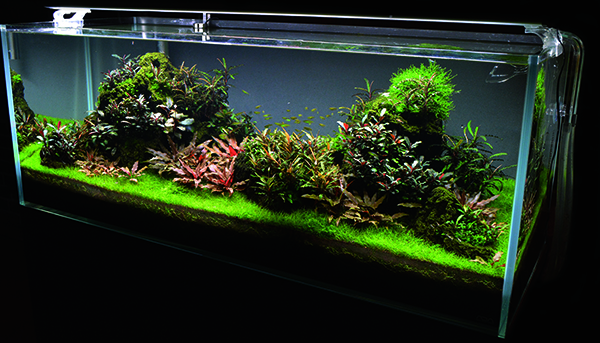
The author’s 65-gallon Nature Aquarium featuring an Unzan stone hardscape mounted with Bucephalandra varieties, a carpet of Eleocharis acicularis, and Cryptocoryne petchii “Pink” is a simple but effective layout based on traditional Nature Aquarium style principles.
However, enchanting as it is, a planted aquarium in the Nature style can be a real challenge for the beginning aquascaper. There are very few definitive how-to resources on this topic available in the English language, and most of the useful information is scattered all across the Internet. I know my early attempts at Nature Aquarium design failed to meet my hopes and expectations; the result of my efforts was an aquarium that resembled a primordial stew more than a Zen masterpiece. I am now a decade or more along the Nature Aquarium path, and though I would not yet consider myself a master, I have learned a few things that might help those just starting out to avoid some frustration, expense, and struggle. I hope this series of articles will make the Nature Aquarium more accessible to aquarists of every experience level. Let’s begin with some thoughts on aquascaping philosophy.
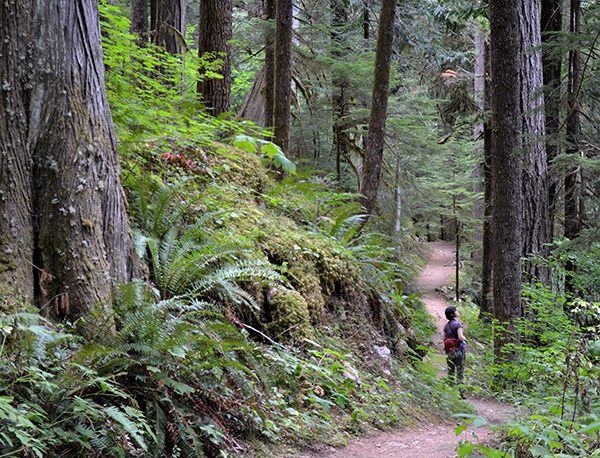
Excursions into wild nature, such as this old growth temperate rainforest trail in Washington’s North Cascades National Park provide the seed for aquascaping inspiration.
Spend time in nature
It was Takashi Amano’s love for the natural world and wild beauty that first inspired him to develop the Nature Aquarium. Getting back to the source of this inspiration by spending ample time outdoors in quiet meditation of the natural patterns and processes that have inspired artists for eons is a great way to enrich your aquascaping style. Even if you don’t have the resources to travel to exotic locales like the Amazon rainforest or the peat swamps of Borneo, you can most likely find an open space or forest nearby and take quiet, contemplative walks. Soak in the natural patterning surrounding you, walk down a wooded trail, make sketches, take snapshots, and, most important, just simply be. Do this often and let nature infiltrate your senses and sensibilities. These experiences will inform your aesthetic intuition, give natural authenticity to your work, and find their way into your aquascapes down the road.
You must learn to grow aquatic plants before you can design an aquascape
I think some of my early failures with aquascaping were the result of the discouraging truth that I simply did not know how to grow aquatic plants and had invested very little research into aquatic horticulture. I had kept aquarium fishes at a high level for decades, and had even created some nice fish habitats using plants like Anubias, Java Fern, and Java Moss, but it’s possible that my years of aquarium experience had given me just enough knowledge to get me into trouble (and just enough aquarist’s ego to make me dangerous).
I had never really thought about my aquatic plants beyond their role in cycling the byproducts of fish metabolism. Plants get all their food from fish waste, right? Other misconceptions bumbled the process. Assuming that a powerful aquarium light with all the bells and whistles would be the key to healthy plant growth, I left my light on for 12 or more hours a day, mimicking the influence of the tropical sun (can you hear the algal time bomb ticking?). After I had committed to the aquascaping path and had a few failed layouts under my belt, it was obvious to me that I need to get down to basics and learn how to grow aquarium plants successfully.
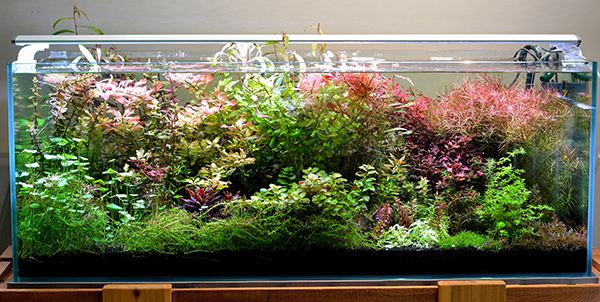
The author’s 65-gallon “farm tank” is a wild stem-plant jungle of diverse colors and form growing for future use in display aquascapes.
Set up a farm tank
For me, the greatest tool for understanding aquatic horticulture has been what I call the “farm tank.” A farm tank is a simple aquarium stripped down to the basics, focused on the single-minded goal of growing aquatic plants well. There is no hardscape (rock or driftwood) in a farm tank. There is no artist’s attempt at orchestrating a harmonious ode to the golden ratio. Fishes, shrimps, and snails do not belong in the farm tank, because this where you are going to experiment with elevated CO2 and nitrogen concentrations that could be harmful to delicate animals. There is a refreshing simplicity to the farm tank’smantra: “Grow!”
In the farm tank there are plants basking in light, plants rooted in nutrient-rich substrate, and plants bathed in a concoction of nutrients, and nothing more. The farm tank is the place where you can learn the basics, earn your chops, and develop the confidence you need to ascend to the next level. A quick note on what I learned from my farm tank experience: my plants responded best to a moderately intense aquarium light left on for eight hours per day, a soil-based substrate like ADA’s Amazonia Aqua Soil (as opposed to inert sand or gravel), a complete cocktail of macro and micro nutrients dispensed on a daily, dilute basis, and injected carbon dioxide. Even now, I always make room in my aquarium collection for a farm tank; I find it really fun to watch the plants grow, and I use it to house the latest plant rarities that my collectoritis invariably causes me to accumulate.
Don’t skimp on equipment
I would like to say that aquascaping is easily accessible to those with even the slimmest of budgets, but the truth of the matter is that this hobby requires some investment. You have to plan on spending money on the right equipment, hardscape materials, substrates, and plants. Nice equipment—like the beautiful, high-clarity rimless aquariums popularly used by aquascapers—will really add to the impact of your aquascape and become a source of pride and living art in your home. If your budget is limited, start out by saving enough money to buy the most beautiful aquarium you can afford. Even if you can’t immediately buy all the lighting, substrates, and filtration that your aquascape requires, you will have this beautiful aquarium in your home to inspire you. You can meditate on your empty vessel and envision all its creative potential. Even if you can afford to outfit your Nature Aquarium from the outset, it is a great exercise to just sit with your empty aquarium for a while rather than rushing to build a layout you might regret later.
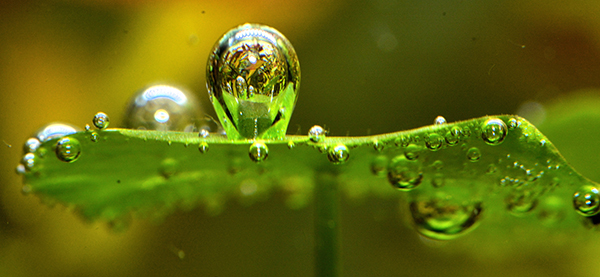
When healthy plants are actively performing photosynthesis in the presence of supplemental carbon dioxide, beautiful bubbles of oxygen can be seen streaming from the leaves.
Carbon dioxide is essential to the execution of a fine aquascape
Plants harness the sun’s energy via photosynthesis, transforming carbon dioxide and water from the environment into carbohydrates and oxygen. Photosynthesis is the process plants use to energize their growth. This fundamental truth of nature is often forgotten by aquarists. It’s well known to most people that plants need light, but a plant’s need for carbon dioxide is less obvious. You don’t have to be a scientist to see or understand the benefits of carbon dioxide in the planted aquarium: Aquarium plants grown with carbon dioxide supplementation grow quickly, displaying perfect leaf form, vibrant colors, and less of that ragged appearance you see in plants that are struggling to survive without enough CO2. The vibrancy and vitality emanating from well-grown plants is what makes a Nature Aquarium aquascape so compelling and enchanting. Carbon dioxide is as essential to a good aquascape as an artistic layout or a beautiful aquarium vessel. Injected CO2 aquariums also are less likely to have nuisance algae. I am not going to go into a deep discussion of CO2 technology, but I will say you definitely need it. If you are planning to stay in the planted aquarium hobby longer than a year, spend the money to invest in a quality regulator with a solenoid and a pressurized gas cylinder; it’ll pay off in years of satisfactory results.
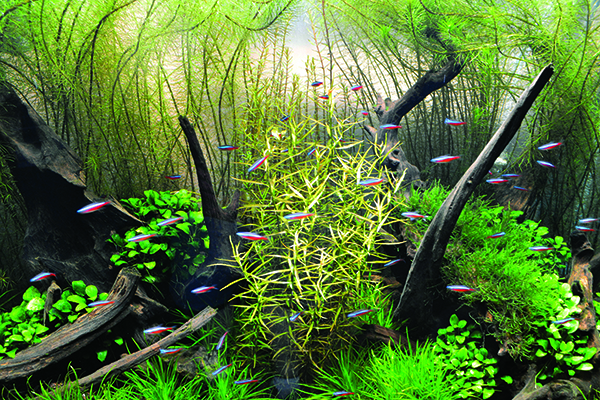
Balance is found in this Nature Aquarium’s shoal of Cardinal Tetras swimming through an underwater forest of Rotala sp. “Vietnam,” Ludwigia arcuata, and Anubias nana “Bonsai.”
Keep it simple
It’s easy to get overwhelmed when starting out along the aquascaping path. The fun (and the frustration) of the planted aquarium is that it is equal parts science and art. You must have both enough knowledge of biology and technical equipment to grow aquarium plants and the creative instincts to compose something beautiful. Good advice on the Internet can often get buried under layers of contradictory information. If you find yourself getting overwhelmed, I suggest stripping your aquascaping goals down to the basics.
Early on, I noticed that Takashi Amano selected mostly simple plants, such as Java Fern, Anubias, Cryptocoryne, Riccia, mosses, and Dwarf Hairgrass (Eleocharis acicularis), for his aquascape layouts. These plants were all staples in his compelling early masterpieces, which launched the whole Nature Aquarium phenomenon. A lot of them are dead easy to grow—they just need be kept wet and get a little light to survive. If you are struggling with growing delicate stem plants or carpets of needy foreground plants, try a basic layout consisting of wood, moss, Crypts, hairgrass, and Java Fern. Enjoy the satisfaction that comes from simplicity. If you are having trouble creating a killer hardscape layout, gather a pile of rocks at a local stream and play outdoors all day, letting the energy of the natural world inform your experiments with the stones and wood you find. Keep it loose and fun, and some fresh energy might make its way into your design.
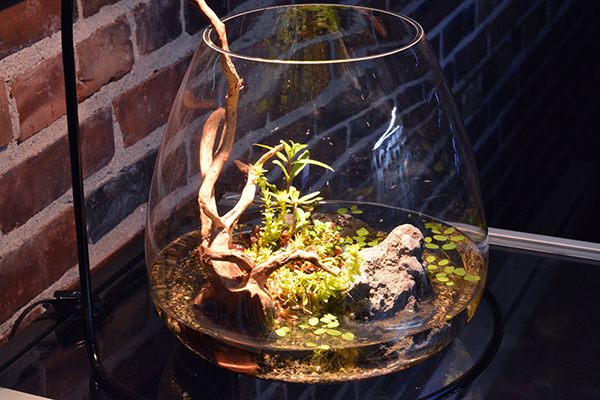
A Wabi-Kusa is a simple and charming miniature expression of the Nature Aquarium philosophy.
One of my favorite simple aquascaping exercises is making a Wabi-Kusa. Another of Takashi Amano’s innovations, it consists of a small glass vessel and a simple collection of aquarium plants growing emersed on a ball of soil with just enough water to keep the roots of the plants wet. If you find my earlier suggestion that a good aquascape requires carbon dioxide to be too complicated and expensive, you will be relieved to know that a Wabi-Kusa requires none of that, as the emersed-growing plants gather CO2 from the air. The point is to have fun and make use of nature—there are infinite ways to do that, even using the simplest techniques.
Study the works of a master
The Nature Aquarium concept is now a few decades old and has attracted aquarists from all over the world. We are in a golden age for aquascaping, and specialized aquarium products are becoming ever more available. There are a number of aquascapers out there who, in my opinion, have mastered the Nature Aquarium and create work at the highest level. Study these aquascapers and their bodies of work. The two large aquascaping contests—Aqua Design Amano’s International Aquatic Plants Layout Contest and the Aquatic Gardeners Association’s International Aquascaping Contest—attract some of the best aquascapers in the world and can be a great source of inspiration for beginners.
One of the cool things about aquascaping is that many top-notch aquascapers are still just average mortals like you and me and can be easily approached for advice or friendship. Social networking is a great way to strike up connections with some of the greats in the field. I find some of my best inspiration in the works of the original master, Takashi Amano. There is a magical harmony and deceptive simplicity in Amano’s work that never fails to blow my mind. Not a day goes by that does not find me flipping through the pages of one of his photo books, astounded with reverence for the man’s talent. A personal goal for my aquascaping path is to continue working in the traditional Nature Aquarium style envisioned by Amano.
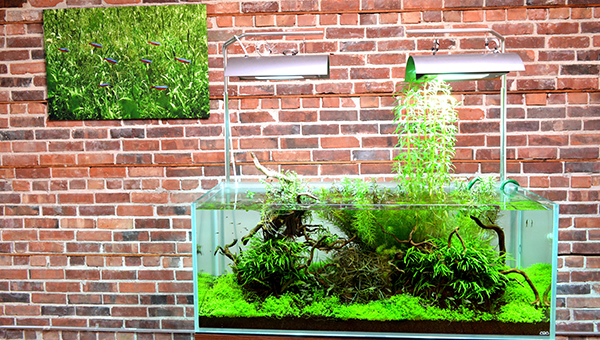
An experimental design anchored in Java Fern clumps, Micranthemum “Monte Carlo,” and with Pogostemon stellatus growing vertically out of the aquarium.
Lose yourself in the process—don’t think about the end result
Most beginning aquascapers will not be able to create masterpieces on the first try—especially without a lot of research or the help of a good mentor. That’s okay. It’s okay to fail or fumble, as long as you are learning skills and improving along the way. Instead of focusing on a pre-formed notion of how amazing your aquarium will look, have fun with the process. Aquariums are dynamic entities that change from day to day—that photo of a beautiful prize-winning aquascape you see plastered all over the Internet is only a snapshot in the lifetime of an aquarium that is constantly changing and evolving.
I find that once started, an aquarium takes on a life of its own, and my most successful aquascapes have been the ones where I have focused on what is working successfully and discarded what is struggling to grow. For example, if the aquarium light that all the Internet “experts” recommended isn’t growing that perfect golf course–like mat of Dwarf Baby Tears and, no matter how many times you attempt it, your underwater bonsai tree looks more like a stick engulfed in a green blob than a wizened old tree sitting atop a mountain pass, that’s all right—you are gaining experience. Show compassion for yourself and your creations; enjoy the process and the research. Try new types of plants when others decline. Experiment with a new layout when the old one fails to excite you. Don’t be afraid to tear everything down and start over. Enjoy simple tasks like doing water changes and trimming plants. The aquascaping process is very therapeutic, and I find that one of the best ways to unwind during stressful times is to turn on some music, tune out the world, and meditatively dive into my aquascape. Even in 20 gallons of water or less, there is an endless well of creative potential in a Nature Aquarium and a path rich enough for a lifetime of discovery.
Steve Waldron is an AMAZONAS senior contributor and the co-founder of the retail aquascaping shop, Aquarium Zen in Seattle, Washington. He is the editor of the English-language edition of Origin of Creation, the official Takashi Amano biography (Aqua Design Amano, 2016).
Don’t miss Steve Waldron’s writing in AMAZONAS—get your own personal subscription, published in handsome, lifetime-reference print and digital editions—free delivery to your home or office.

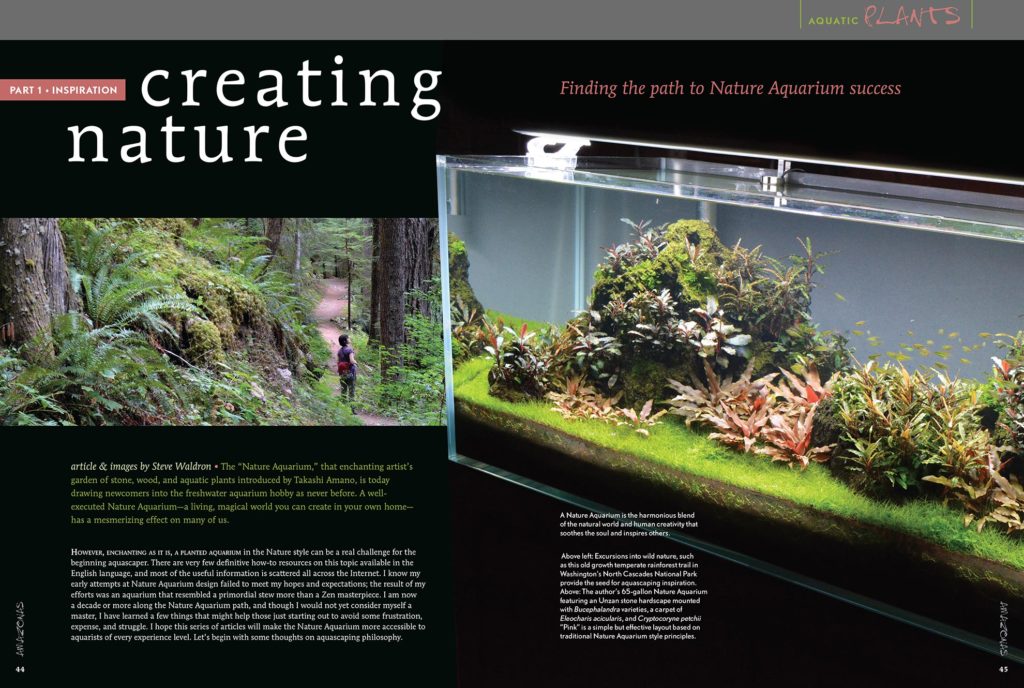





Steve, you have presented a wonderful illustration on developing Planted tanks. It is well focused keeping the hobbyist in mind. It draws the reader into challenges that may never be undertaken, unless one’s curiosity is transformed into action. As failures are acknowledged, one learns from past mistakes, until perfection in this natural craft with nature makes a beautiful blend. The challenges that present result in total splendor. Don’t think too hard of when to start. Start now before the ink on this paper dries. Thanks to Steve for his many contributions to the Planted Tank.
Thank you very much Walter! I appreciate your poetic feedback
– Steve
Steve, as usual you have done a wonderful job. I hope to come by your store and see you in a couple weeks when we come to visit family in Tacoma. Closest thing to your store I’ve found here so far is Arizona Nature Aquatics Store in Tucson…but…welll…it’s not Steve Waldron and Aquatic Zen. Great article…!
Thanks Ron! Glad you enjoyed the article and it was great to see you again. I envy your tan!
– Steve